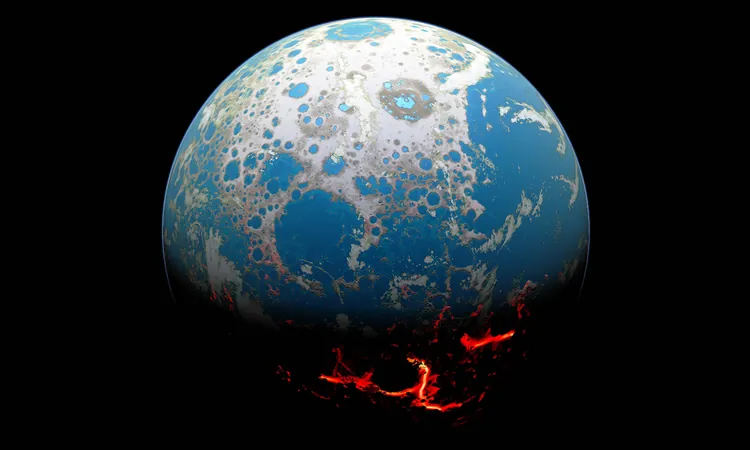
Groundbreaking Discovery: Ancient Bacteria Used Oxygen Nearly a Billion Years Earlier Than Expected!
2025-04-06
Author: Ming
Life on Earth: A History
Life on Earth dates back at least 3.7 billion years, with microorganisms at the forefront of this ancient existence. For years, researchers have grappled with pinpointing the timeline of microbial life, but a new study has unveiled a stunning revelation: certain bacteria harnessed oxygen nearly one billion years earlier than previously believed.
The Research Team and Their Findings
Conducted by Dr. Adrián Arellano Davín and his team at the Okinawa Institute of Science and Technology (OIST), this research reveals an unexpected connection between early oxygen tolerance and the evolution of photosynthesis.
What Was the Great Oxidation Event?
The Great Oxidation Event (GOE) is a critical milestone in Earth’s history, occurring around 2.4 billion years ago when atmospheric oxygen levels began to rise significantly. Before this event, Earth was largely devoid of oxygen, with life forms primarily composed of primitive microbes that thrived in anaerobic environments. This new research suggests, however, that certain bacterial groups had already begun to exploit oxygen in localized environments long before it became abundant in the atmosphere.
These early oxygen-using bacteria likely found themselves in pockets of the Earth's surface where trace amounts of oxygen were present, potentially paving the way for modern aerobic respiration. The discovery implies that the evolution of oxygen metabolism may have given these bacteria a competitive advantage, equipping them to thrive as oxygen levels increased.
The Role of Machine Learning in Evolutionary Studies
Using cutting-edge machine learning techniques and phylogenetic analyses, researchers could trace which bacterial ancestors made the switch from anaerobic to aerobic lifestyles. By scrutinizing patterns from 1,007 modern bacterial genomes, the scientists reconstructed the evolutionary map of how these changes occurred. This adaptive capacity allowed the bacteria to spread further and diversify much more efficiently once the atmosphere became oxygen-rich.
Cyanobacteria, notorious for their role in introducing oxygenic photosynthesis into the planet's biosphere, emerge as a key player in this narrative. Not only did some ancestral forms appear to tolerate oxygen prior to the GOE, but these adaptations may have facilitated the development of the photosynthetic processes we see today.
Tracing Evolution Through Genomic and Geological Evidence
Researchers extended bacterial family histories back to the Hadean or early Archaean eons, approximately 4.4 to 3.9 billion years ago. Evidence indicates that several significant bacterial lineages had already adapted to utilize oxygen, and those that harnessed this resource thrived as atmospheric conditions evolved.
While microbial fossils are scarce, the combination of chemical signals found in ancient sediments and sophisticated computational modeling helps fill the gaps in our understanding of early microbial life. This multifaceted approach illuminates key questions regarding the conditions that promoted the emergence of not just bacteria, but ultimately, eukaryotic cells and complex life forms.
Looking Ahead: What’s Next in This Research?
As researchers continue to delve into the mechanics of life's early adaptations, questions linger regarding the nature and scale of the early oxygen environments. Did other organisms, beyond bacteria, adapt to these oxygen-rich locales? The implications of understanding these ancient ecosystems extend far beyond microbial life, potentially providing insights into the rise of multicellular organisms, animals, and plants—the building blocks of today's biosphere.
This breakthrough reveals that early microbial tolerance to oxygen might have significantly influenced the evolution of life as we know it. The ongoing exploration into the ancient Earth and its life forms not only enriches our history but also informs our understanding of life’s resilience and adaptability.
Stay tuned for further updates as scientists work to unravel the complexities of our planet's primordial past!
*Published in the journal Science, this captivating study invites us to reconsider the origins and evolution of life on Earth.*


 Brasil (PT)
Brasil (PT)
 Canada (EN)
Canada (EN)
 Chile (ES)
Chile (ES)
 Česko (CS)
Česko (CS)
 대한민국 (KO)
대한민국 (KO)
 España (ES)
España (ES)
 France (FR)
France (FR)
 Hong Kong (EN)
Hong Kong (EN)
 Italia (IT)
Italia (IT)
 日本 (JA)
日本 (JA)
 Magyarország (HU)
Magyarország (HU)
 Norge (NO)
Norge (NO)
 Polska (PL)
Polska (PL)
 Schweiz (DE)
Schweiz (DE)
 Singapore (EN)
Singapore (EN)
 Sverige (SV)
Sverige (SV)
 Suomi (FI)
Suomi (FI)
 Türkiye (TR)
Türkiye (TR)
 الإمارات العربية المتحدة (AR)
الإمارات العربية المتحدة (AR)